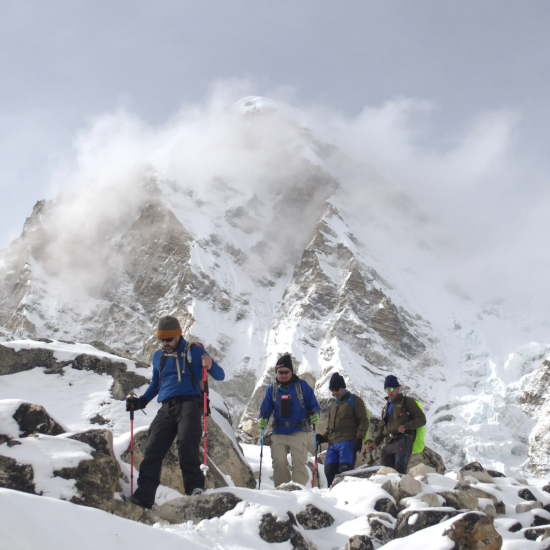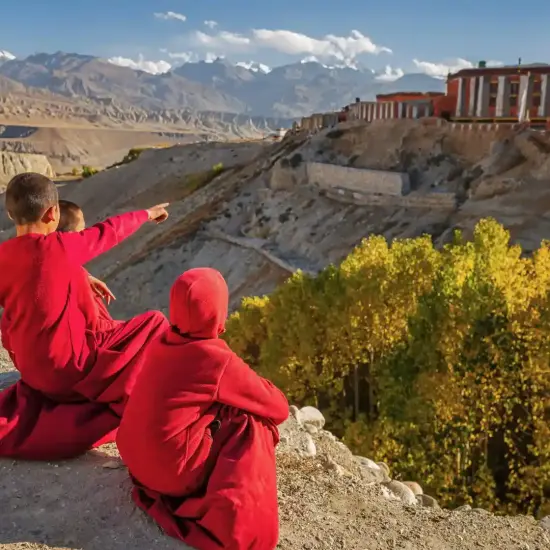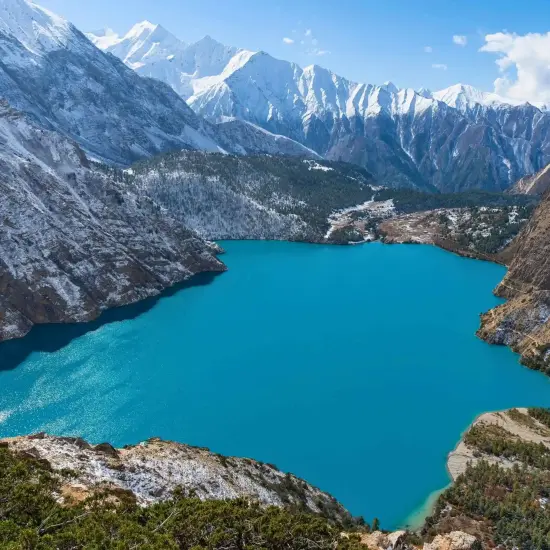Trekking in Nepal is possible even during the monsoon season. Monsoon trekking is one of the popular choices of trekkers due to many reasons. While some regions do get tough to reach, some trekking trails such as Taplejung Treks
Trekking in Nepal is possible even during the monsoon season. Monsoon trekking is one of the popular choices of trekkers due to many reasons. While some regions do get tough to reach, some trekking trails such as Taplejung Treks are made to travel during the monsoon season. Mountain hiking trails in Nepal such as Everest Base Camp Trek, Upper Mustang, and Makalu Barun Trek are often sought during the monsoon season.
Even though Trekking in Nepal during the monsoon season is possible, getting around the hilly region of Nepal can be quite risky. The monsoon/summer season in Nepal from June to early September brings heavy rains, making trekking routes muddy and increasing the chances of landslides, flooding, and blocked trails. Due to these risks, only select treks are suitable when such factors pose a lower threat.
Fall and spring in Nepal can be the best season for trekking in Nepal while trekking during the monsoon season in Nepal presents challenges, it also offers its unique rewards. The trails are less crowded and you can have the mountains all to yourself and the mountains.
The most popular monsoon trekking destinations in Nepal are the rain shadow areas of the Himalayas, such as Upper Mustang, Upper Dolpo, Jomsom, and Muktinath. While incessant rains and high temperatures make trekking challenging in the Terai and hilly regions, the tall Himalayas block the rainfall, resulting in drier conditions on the other side. These areas offer ideal trekking conditions with warm days, clear weather after morning showers, fewer chances of altitude sickness, and fewer crowds on trails and teahouses compared to the busier autumn season giving the ultimate rainy season adventure in Nepal. Places Nepal brings you some popular and accessible trekking trails in Nepal that can be completed during the monsoon & rainy season.
The Monsoon Season in Nepal
Nepal experiences its annual monsoon season from June to August. It is during this time that large rain clouds form over the sea south of India and make their way across the country, colliding with the cooler air of the Himalayas and releasing torrential rain.
Most parts of Nepal encounter abrupt and intense downpours, although specific mountainous regions, such as the Upper Mustang region and parts of the Annapurna circuit, especially Jomsom, remain relatively dry throughout the year due to the rain shadow effect of the Himalayas. Jomsom, for instance, receives only 30mm of rain in August, the peak monsoon month, while Pokhara, on the other hand, receives a substantial 850mm. Even during the monsoon season, rainfall seldom lasts for extended periods, presenting intrepid visitors with an opportunity to experience cultural attractions and drier trekking trails with minimal crowds.
Ghorepani Poon hill Trek
The Ghorepani trek can be quite wet with poor visibility during the peak monsoon months of July and August. However, the trails are wide, well-established with steps, and relatively free from leeches. The early and late monsoon periods can be an excellent time for this trek, as you'll likely encounter fewer crowds while still getting clear views when the clouds part.
Trek the Ghorepani Poon Hill Trek
Wake Up to the Himalayas – A Short Trek with Timeless Sunrise Views
Mardi Himal Trek
The Mardi Himal, 5,587-metre (18,330 ft) treks east of Annapurna Base Camp, have recently gained immense popularity. This trek offers breathtaking views of the Annapurna range, with a special focus on the majestic Mt. Machapuchare. In addition to the Himalayan vistas, trekkers can enjoy the mesmerizing sight of clouds settling in the valley during the morning hours. The sunrises and sunsets are truly spectacular.
During the monsoon season, the trail is relatively quieter, and the forest appears lush with ferns and moss. However, trekkers should be cautious of leeches. The trail features some steep sections, making it moderately difficult. Proper gear, including insect repellent and high-performance hiking shoes, is recommended for this trek.
Trek the Mardi Himal Base Camp Trek
This trek offers stunning views of the Annapurnas and Machhapuchhre, with scenic forests, villages, and peaceful meadows for an unforgettable adventure.
The Annapurna Circuit Trek
The upper sections of the Annapurna Circuit trek, including Manang, Thorong La Pass, and Muktinath, fall under the rain-shadow region. During the monsoon period, the views of the Annapurna mountains and Muktinath are breathtakingly stunning. Additionally, the agricultural fields in Manang appear lush and vibrantly green due to the rainfall. The well-marked trails make navigation easy, and the hospitable Nepali teahouses and friendly locals ensure ample opportunities for rest, nourishment, and cultural exchange throughout the trek.
Trek the Annapurna Circuit Trek
A legendary high-altitude trek in Nepal that encircles the Annapurna Massif, offering dramatic scenery, diverse cultures, and the iconic crossing of Thorong La Pass at 5,416 meters.
Dolpo Circuit Trek
Dolpa is an underrated yet rewarding trekking destination in Nepal. Closed to foreigners until 1989, the region maintains an aura of mystery. For those seeking an escape from the world and a reconnection with nature, Dolpa is an ideal spot. The trek centers around Lake Phoksundo, Nepal's deepest lake, which appears magical with its rich blue hue nestled amidst the mountains. Beyond its natural beauty, Dolpa offers a wealth of cultural experiences, including learning about Buddhist traditions at the Tshowa Monastery.
Everest Base Camp Trek
Experiencing the Everest Base Camp Trek is a once-in-a-lifetime adventure that offers breathtaking views, challenging terrains, and a chance to connect with one of the world's highest peaks. This 15-day trek is not for the faint of heart but for those seeking an unforgettable experience that pushes their limits. The best part is, that it can be completed effortlessly even during the monsoon season.
The Lower Everest trek offers visitors the opportunity to explore the Numbur Himalayan range and Dudhkunda Pokhari, which hold religious and natural significance. Another highlight is Ratnangee Danda (Hill), a viewpoint near Phaplu Airport situated at an elevation of around 3,100 meters. From this vantage point, trekkers can witness stunning views of Mount Everest, Makalu, and, as well as breathtaking sunrises and sunsets.
Trek the Everest Base Camp Trek
This classic trek takes you through the heart of the Khumbu region, past vibrant Sherpa villages, ancient monasteries, and towering Himalayan peaks.
Lower Mustang Trek
Lower Mustang offers several trekking routes and day hikes, including a six-day itinerary. To reach this region from Kathmandu, travelers need to take a couple of flights, so it's essential to factor in buffer time for potential flight delays. An alternative is to drive to Jomsom, but road conditions often need improvement during the peak monsoon months of July and August. Accessing Lower Mustang requires flexibility with your schedule. If you're on a tight timeline, this trek may not be the best option for you during the monsoon season.
Upper Mustang Trek
The Upper Mustang Trek is one of the best monsoon treks in Nepal, thanks to its location in the trans-Himalayan region. Shielded by the towering Annapurna and Dhaulagiri ranges, it lies in a natural rain shadow, receiving very little rainfall even during the peak monsoon months of June to August. This makes it one of the few dry and accessible trekking routes in Nepal during the summer season.
Trekking through Upper Mustang feels like stepping into a different world. You'll walk past barren cliffs, wind-sculpted canyons, and ancient caves while exploring traditional Tibetan-style villages and Buddhist monasteries. The crown jewel of this trek is the medieval walled city of Lo Manthang, with its whitewashed palaces, ancient gompas, and timeless spiritual atmosphere. During monsoon, the skies often clear beautifully after brief showers, revealing dramatic mountain views and green fields in full bloom. The dry trails, vibrant culture, and fewer crowds make Upper Mustang a hidden treasure for summer trekking in Nepal.
Trek the Upper Mustang Trek
A 100 km cultural trek through Mustang’s dry, scenic trails—moderate, manageable, and rich in heritage.
Nar Phu Valley Trek
The Nar Phu Valley Trek is a rugged, high-altitude adventure that offers a rare blend of dramatic Himalayan scenery and authentic Tibetan culture. Situated in the rain-shadow area northeast of the Annapurna range, this trek remains relatively dry even during the monsoon season, making it a great alternative for experienced trekkers seeking remote trails.
The route winds through deep gorges, ancient stone villages, yak pastures, and high alpine valleys. The hidden villages of Nar and Phu are cultural gems, home to centuries-old Buddhist traditions, prayer walls, and monasteries rarely seen by the average trekker. Trekkers who cross the Kang La Pass (5,322m) are rewarded with panoramic views of the Annapurna and Dhaulagiri ranges. During monsoon, the valleys come alive with blooming wildflowers and rushing waterfalls, while the high-altitude areas stay relatively dry and quiet. If you're looking for an off-the-beaten-path trek in Nepal during the monsoon, the Nar Phu Valley is a perfect choice.
Trek the Nar Phu Valley Trek
Trek around the world's third-highest peak, featuring Himalayan views and rich cultural encounters. Ideal for experienced trekkers, it takes you through untouched landscapes and Tibetan villages.
Phoksundo Lake Trek
The Phoksundo Lake Trek is ideal for trekkers looking for a short but magical journey in western Nepal during the monsoon. Located in the Dolpo region, which lies in the rain shadow of the Himalayas, this trail remains fairly dry throughout the summer months, unlike the southern hills and valleys of Nepal.
The trek takes you through beautiful forests, traditional Bonpo villages like Ringmo, and to the turquoise-blue Shey Phoksundo Lake—Nepal’s deepest and one of its most spectacular high-altitude lakes. Surrounded by steep cliffs and snow-capped peaks, the lake glows brilliantly after rain showers, offering breathtaking scenery. Monsoon enhances the natural beauty of this region, with gushing waterfalls and vibrant greenery adding to the experience. Cultural highlights include visiting Tshowa Gompa, a 900-year-old monastery perched on a cliff above the lake. The Phoksundo Lake Trek is a peaceful and spiritual escape, perfect for monsoon trekking in a lesser-traveled part of Nepal.
Trek the Shey Phoksundo Lake Trek
This trek offers a unique blend of natural beauty, Tibetan culture, and rugged terrain, perfect for those seeking an off-the-beaten-path adventure.
Api Himal Base Camp Trek
The Api Himal Base Camp Trek is a remote and scenic adventure into the far-western Himalayas of Nepal, offering an untouched trekking experience even during the monsoon season. While this region does receive some rainfall, it remains relatively unexplored and is perfect for adventurers looking to connect with nature and culture far from the mainstream trails.
This trek leads you through lush forests, terraced farmland, and high-altitude meadows to the base of Mt. Api (7,132m)—the highest peak in western Nepal. The journey begins from Gokuleshwar and takes you through isolated villages inhabited by the Byasi and Rautes, indigenous ethnic groups with unique lifestyles and traditions. During the monsoon months, the trail transforms with greenery, wildflowers, and flowing streams. The clouds often part after rain to reveal awe-inspiring mountain views, and the peace of the area is unmatched. Though less developed than popular trekking routes, the Api Himal Base Camp Trek is ideal for those seeking a monsoon trekking destination that is raw, spiritual, and photogenic.
Trek the Api Himal Base Camp Trek
Where Silence Meets the Sacred – Trek Beyond the Map.
Other than that, for beginners looking for short treks in Nepal during monsoon season, Cultural city tours in places like Kathmandu, Pokhara, and Lumbini, and safari activities in Chitwan National Park can be enjoyed year-round without issues during the monsoon season. Additionally, some shorter treks such as the Chisapani Trek, Nagarkot Trek, Sarangkot Hike, Ghandruk Trek, and Ghorepani Poon Hill Trek are possible options for trekking in Nepal during the monsoon months.
Monsoon Trekking Essential GearList
You can face many challenges during monsoon trekking in Nepal due to the risk of heavy rainfall, landslides, floods, steep roads, and many more. But if you prepare for the risks and challenges to come you can experience the best monsoon trek in Nepal. Some tips that'll help you guide during the monsoon treks are:
- Pack high-quality, breathable rain protection gear.
- Ensure your footwear is waterproof or quick-drying.
- Use waterproof bags or cases to protect your electronic devices.
- During the monsoon season, it is advisable to use tourist buses rather than local transportation options.
- During the monsoon season in Nepal, flights frequently get canceled. It is recommended to book the first flight of the day as if it gets canceled, there is a higher chance that flights may not operate again until the afternoon or the following day.
- Stay in good accommodation
- Choose trekking routes and the best regions that are not affected by the monsoon season























